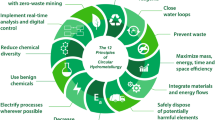Abstract
The neutral zinc sulfate solution obtained from hydrometallurgical process of Angouran zinc concentrate has cadmium, nickel and cobalt impurities, that must be purified before electrowinning. Therefore, cadmium and nickel are usually cemented out by addition of zinc dust and remained nickel and cobalt cemented out at second stage with zinc powder and arsenic trioxide. In this research, a new approach is described for determination of effective parameters and optimization of zinc electrolyte hot purification process using statistical design of experiments. The Taguchi method based on orthogonal array design (OAD) has been used to arrange the experimental runs. The experimental conditions involved in the work are as follows: the temperature range of 70−90 °C for reaction temperature (T), 30−90 min for reaction time (t), 2−4 g/L for zinc powder mass concentration (M), one to five series for zinc dust particle size distributions (S 1-S 5), and 0.1−0.5 g/L (C) for arsenic trioxide mass concentration. Optimum conditions for hot purification obtained in this work are T4 (85 °C), t 4=75 min, M 4=3.5 g/L, S 4 (Serie 4), and C 2=0.2 g/L.
Similar content being viewed by others
References
MOGHADDAM J, MAMOORY R S, ABDOLLAHY M, YAMINI Y. Purification of zinc ammoniacal leaching solution by cementation: Determination of optimum process conditions with experimental design by Taguchi’s method [J]. Separation and Purification Technology, 2006, 51(2): 157–164.
NELSON A, DEMOPOULOS G P, HOULACHI G. The effect of solution constituents and novel activators on cobalt cementation [J]. Canadian Metallurgical Quarterly, 2000, 39(2): 175–186.
NELSON A, WANG W, DEMOPOULOS G P, HOULACHI G. The removal of cobalt from zinc electrolyte by cementation: A critical review [J]. Mineral Processing and Extractive Metallurgy Review: An International Journal, 2000, 20(4/5/6): 325–356.
BEHNAJADY B, BALESINI A A, MOGHADDAM J. A new approach to the optimisation of zinc electrolyte cold purification process by Taguchi’s method [J]. Canadian Metallurgical Quarterly, 2014, 53(3): 333–339.
KARVASTEVA M. The effect of certain surfactants on the cementation of cobalt from zinc sulfate solutions by suspended zinc particles in the presence of copper or antimony [J]. Canadian Metallurgical Quarterly, 2001, 40(2): 179–184.
ZHANG H, LI Y, WANG J, HONG X. The influence of nickel ions on the long period electrowinning of zinc from sulfate electrolytes [J]. Hydrometallurgy, 2009, 99(1/2): 127–130.
SARANGI C K, TRIPATHY B C, BATTACHARYA I N, SUBBAIAH T, DAS S C, MISHRA B k. Electrowinning of zinc from sulphate solutions in the presence of perfluoroglutaric acid [J]. Minerals Engineering, 2009, 22(14): 1266–1269.
DREHER T M, NELSON A, DEMOPOULOS G P, FILIPPOU D. The kinetics of cobalt removal by cementation from an industrial zinc electrolyte in the presence of Cu, Cd, Pb, Sb and Sn additives [J]. Hydrometallurgy, 2001, 60(2): 105–116.
SINGH V. Technological innovation in the zinc electrolyte purification process of a hydrometallurgical zinc plant through reduction in zinc dust consumption [J]. Hydrometallurgy, 2000, 40(1/2): 247–262.
MOGHADDAM J, MAMOORY R S, YAMINI Y, ABDOLLAHY M. Determination of optimum conditions for the leaching of nonsulphide zinc ores (high SiO2) in ammonium carbonate media [J]. Industrial & Engineering Chemistry Research, 2005, 44(24): 8952–8958.
RAGHAVAN R, MOHANAN P K, VERMA S K. Modified zinc sulphate solution purification technique to obtain low levels of cobalt for the zinc electrowinning process [J]. Hydrometallurgy, 1999, 51(2): 187–206
ÇOPUR M C, OZMETIN C, OZMETIN E, KOCAKERIM M M. Optimization study of the leaching of roasted zinc sulphide concentrate with sulphuric acid solutions [J]. Chemical Engineering and Processing: Process Intensification, 2004, 43(8): 1007–1014.
MOGHADDAM J, KOLAHGAR-AZARI S, KARIMI S. Determination of optimum conditions for nano-silver preparation from AgCl based on the taguchi design by the use of optical properties of silver [J]. Industrial & Engineering Chemistry Research, 2012, 51(8): 3224–3228.
BEHNAJADY B, MOGHADDAM J, BEHANJADY M A, RASHCHI F. Determination of the optimum conditions for the leaching of lead from zinc plant residues in NaCl-H2SO4-Ca(OH)2 media by the Taguchi method [J]. Industrial & Engineering Chemistry Research, 2012, 51(10): 3887–3894.
ROY R K. A primer on the taguchi method [M]. New York: van Nostrand Reinhold, 1995.
Author information
Authors and Affiliations
Corresponding author
Rights and permissions
About this article
Cite this article
Behnajady, B., Moghaddam, J. Statistical evaluation and optimization of zinc electrolyte hot purification process by Taguchi method. J. Cent. South Univ. 22, 2066–2072 (2015). https://doi.org/10.1007/s11771-015-2730-4
Received:
Accepted:
Published:
Issue Date:
DOI: https://doi.org/10.1007/s11771-015-2730-4




